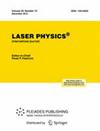关于热激光等离子体电子能谱的分布函数
IF 1.1
4区 物理与天体物理
Q4 OPTICS
引用次数: 0
摘要
在超短(和超高强度)激光脉冲与物质的相互作用中产生的热等离子体的电子发射通常用所谓的 "热电子温度 "来描述。本文指出,这个数字并不明确。原因如下:要给电子能谱分配温度,必须用分布函数来描述能谱。然而,不同类型的分布函数,如波尔兹曼分布函数或麦克斯韦分布函数,尽管提供了几乎相同形式的电子能谱,却导致了不同的电子温度。因此,本文介绍了所有这些分布函数的主要特点,并进行了比较。根据所使用的分布函数不同,热电子温度的数值最多会相差 30%,在极端情况下甚至会相差四倍以上。在比较热电子温度值时,应始终牢记这一点。此外,还讨论了使用平衡分布来描述激光产生的电子特性的原因--尽管可能并不存在热力学平衡。本文章由计算机程序翻译,如有差异,请以英文原文为准。
On the distribution function of electron spectra from hot laser plasmas
The emission of electrons from hot plasmas generated in the interaction of ultra-short (and ultra-high intensity) laser pulses with matter is often characterized by the so-called ‘hot electron temperature’. In this article it is shown that this number is not unambiguous. The reason is the following: to assign a temperature to an electron spectrum, it is necessary to describe the spectrum with a distribution function. However, different types of distribution functions are in use, e.g. the Boltzmann or Maxwell distribution, leading to different electron temperatures in spite of providing nearly the same form of the electron spectrum. For this reason, the main characteristics of all these distribution functions are presented in this article and compared. Depending on the distribution function used, the value of the hot electron temperature varies by up to 30% and in extreme cases by more than a factor of four. This fact should always be kept in mind when comparing values of hot electron temperatures. In addition, the reasons for using equilibrium distributions to describe the characteristics of laser-produced electrons—although probably no thermodynamic equilibrium is prevailing—are discussed.
求助全文
通过发布文献求助,成功后即可免费获取论文全文。
去求助
来源期刊

Laser Physics
物理-光学
CiteScore
2.60
自引率
8.30%
发文量
127
审稿时长
2.2 months
期刊介绍:
Laser Physics offers a comprehensive view of theoretical and experimental laser research and applications. Articles cover every aspect of modern laser physics and quantum electronics, emphasizing physical effects in various media (solid, gaseous, liquid) leading to the generation of laser radiation; peculiarities of propagation of laser radiation; problems involving impact of laser radiation on various substances and the emerging physical effects, including coherent ones; the applied use of lasers and laser spectroscopy; the processing and storage of information; and more.
The full list of subject areas covered is as follows:
-physics of lasers-
fibre optics and fibre lasers-
quantum optics and quantum information science-
ultrafast optics and strong-field physics-
nonlinear optics-
physics of cold trapped atoms-
laser methods in chemistry, biology, medicine and ecology-
laser spectroscopy-
novel laser materials and lasers-
optics of nanomaterials-
interaction of laser radiation with matter-
laser interaction with solids-
photonics
 求助内容:
求助内容: 应助结果提醒方式:
应助结果提醒方式:


